
It's been a dream of mine to be able to do a trip around Lesotho on my motorcycle. Knowing that I was limited to black top driving, the challenge would be to map out a route that would not only be exhilarating to ride, but safe for my tarmac-hugging cruiser........... and me.
So over a rainy Easter weekend - 21st to 24th March 2019, I was accompanied on the "dry" run by 3 great travelling companions - namely Danie Nienaber (VF483), Thom Peeters (VO486) and my son Dylan Meise (VO508) - where we investigated a route that was going to be worthy of a great round trip that was to be the Lesotho Sandstone Challenge.
Please note that most of the coloured text below will be hyperlinked to show my references or to show you the place in Google Maps - it will always open in another page.
Thanks to my travel companions Dylan Meise, Thom (met 'n Ha) Peeters & Danie Nienaber - all who helped set up this challenge, tuck me in at night and read me bedtime stories!


Lesotho - The Mountain Kingdom

Lesotho is a high-altitude, landlocked kingdom encircled by South Africa. It is crisscrossed by a network of river systems and is the source of the mighty Orange River. Known also as the “Mountain Kingdom” - The Maloti (Maluti) mountain range dominates northern Lesotho, trending off to the southwest from the Great Escarpment of the Drakensberg Range. At 3,482m high, the peak of Thabana Ntlenyana ("beautiful little mountain") is highest point of Lesotho and the highest mountain in Africa south of Kilimanjaro.

The mystique of the Drakensberg (‘Dragon”) Mountains extends way back to a time when the area was a vast swampland interspersed with forests dripping with rain, and dinosaurs roamed freely. Then the winds changed, swamps dried, forests died, and the dinosaurs could not survive. The winds continued to blow, all the while piling up sand where the swamps had been, creating colourful layers of orange, yellow and gold to form a magnificent heritage of sandstone mountains.

The Golden Gate National Park is located in the north-eastern part of the Free State and derives its name from the brilliant shades of gold cast by the sun on the sandstone cliffs, especially the imposing Brandwag rock. The area is famous for its captivating scenery, invigorating climate and the accommodation offered in hotel rooms, rondavels and self-catering chalets.
There are 3 main layers of rock in Golden Gate Highlands National Park close to Clarens, the characteristics of which have led to the famous cliff formations present in the park today.
The red layer was created 200 million years ago when swampy rivers deposited the mud-like sediment. 196 million years ago, the area dried up and became a desert, resulting in the yellow sandstone deposits. From 160-190 million years ago, volcanic activity capped the area with a basalt layer. The rivers and streams in the park have carved the rocks into their present formations.

No visit to Golden Gate would be complete without a hike to the top of the Brandwag Buttress (a rock-climbing feature). This sandstone cliff adorns many of the postcards associated with the park as it has a golden glow at sunrise and sunset; hence the name Golden Gate.
Sandstone buildings are synonymous with the eastern Free State. In fact, in almost every small town around the perimeter of Lesotho, you’ll find an example of this architectural building material. Such is the quality and splendour of Free State sandstone that it has inspired some of the country’s most important structures – including the Union Buildings in Pretoria.


The Lesotho Sandstone Challenge:

The idea of this challenge is to travel as close as possible to the Lesotho border – ideally on, but not limited to tarred roads. At all times, one can view the mountainous profile of Lesotho whether you are travelling clockwise or anticlockwise. At no time are you required to enter Lesotho itself.
With sandstone being such a common rock feature around Lesotho, much of the architecture is founded on sandstone building blocks. Eighteen structures including churches and government buildings have been identified in towns along the route and will need to be located and photographed along with rider and bike.
Trip Notes:
• This is a round trip of about 1350 km if done on tar.
• The route and distance are not "set in stone" - as long as all 18 points are tagged. • Easily done in 3 days – a bit of a hard ride for 2 days due to winding roads and passes. • You can enter at any point of the circle, but must return to the same. • The route can be done clockwise or anticlockwise. • Perfect for access from all provinces. • If planned carefully, no toll roads need be ridden. • Fuel slip at entry point is required – along with date and km recorded. • Fuel slip at exit point is required – along with date and km recorded. • A photograph of bike, rider and 18x sandstone structures are to be submitted. • If the rider is on his/ her own – a photo of the bike and structure only is permitted. • Timing of the trip is essential. Winter would see most of the towns encountered being prone to snowfalls!! • Rain and changing road conditions must always be a consideration. • Detailed maps, forms and GPS file will be supplied on registration.
Compulsory & Alternative Points
• CP: Compulsory points must be located and are chosen for easy access from main tarred routes. There are 18 of these, each with their own unique number.
• AP: Alternative points are provided as back-up locations – some of which may be a little off the main route.
CP01: Entrance Wall - Clarens
Clarens is a small South African town situated in the foothills of the Maluti Mountains - watched over by a huge sandstone formation aptly named Titanic Rock and nicknamed the "Jewel of the Eastern Free State". It was established in 1912 and named after the town of Clarens in Switzerland where exiled Paul Kruger spent his last days.
It is a town worth spending time in due to its rich art culture, accommodation and dining establishments.
Many of the town’s buildings are worthy, but we have chosen the sandstone wall at the entrance to Clarens as being the ideal spot provide a photograph:

Other notable structures around the town square are:
• AP01a – Grouse & Claret Pub • AP01b – Purple Onion Shop • AP01c – Clarens Dutch Reformed Church
Here the fabulous four sip on iced tea at the Grouse & Claret before embarking on the weekend adventure!


CP02: Filling Station - Golden Gate Highlands National Park
The Golden Gate Park was established in 1963 to protect the sandstone rocks that were once shelters for the Bushmen. Guests can view many of their cave paintings that are well preserved.
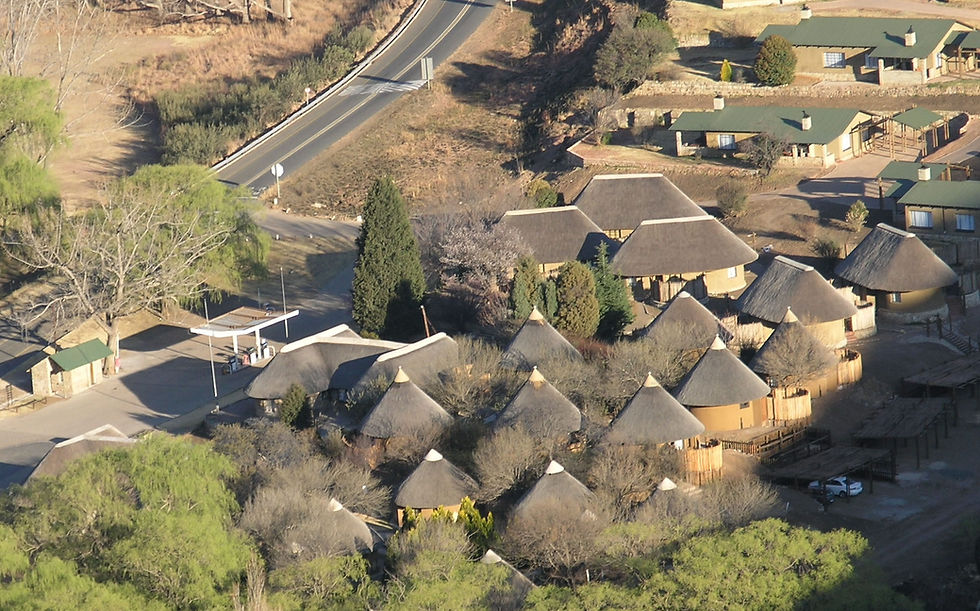
Due to the Golden Gate rock features being a focal point of this challenge, it is fitting that this is a compulsory stop. The sandstone ablution block at the filling station seen below makes for a convenient photograph - plus a pit stop for iced tea consumed in Clarens!

CP03: The Phatt Chef Roadside Diner - Oliviershoek Pass
The Oliviershoek Pass, stretching between the R712 from Harrismith and on along the R74 to Bergville, has been recently refurbished in 2016 and is often used as an alternative route to Van Reenen’s Pass.
Much of the Oliviershoek Pass overlooks the Northern Drakensberg, as it sweeps upward. Those in the know use this, the Amphitheatre, and the Sterkfontein dam combined into a wonderful scenic drive.
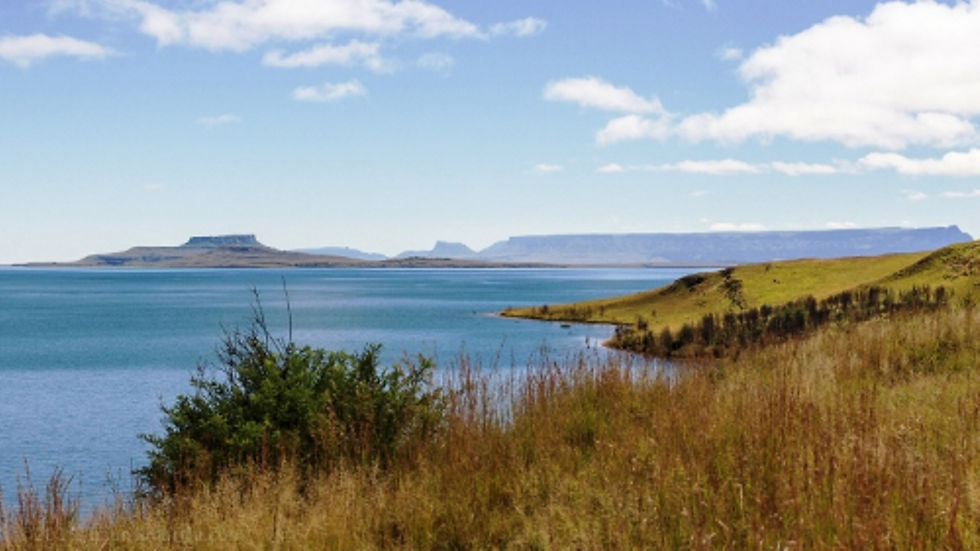

Officially, the pass straddles the border between KwaZulu-Natal and the Free State and begins its climb just south of the Sterkfontein Dam Nature Reserve. It was along this same pass, on 19 October 1837, that Piet Retief and his trek party climbed the Drakensberg.
CP03 - The Phatt Chef Roadside Diner and B&B is to be found at the top of the Oliviershoek Pass at the border between KwaZulu-Natal and the Free State. The best picture for the challenge can be taken in front of the Phat Chef signage, as seen below.
Previously called the Caterpillar and Catfish Cookhouse restaurant, it was built in 1936 by Otto Zunckel, a member of the Berlin Missionary Society which arrived in Africa in 1850 to build the Emmaus mission station and hospital.
Zunckel was also the founder of the much-loved Cathedral Peak and Royal Natal National Park hotels, and he built this house as the ideal spot to retire to after a busy life as a hotelier.
Directly across from the Phatt Chef, is the Oliviershoek Pass viewpoint – well worth visiting.
Other attractions in the area include Sterkfontein Dam, Retief Klip, Kaalvoetvrou Monument, Tugela Falls & Gorge Walk (2nd highest waterfall in the world), Royal Natal National Park Drakensberg World Heritage Site, Tugela Vaal Pumped Storage Scheme, San (Bushman) Rock Art & World Class Yellowfish Angling.
CP04: Museum - Winterton
Winterton is a little town found on the banks of the Tugela River in the foothills of the Drakensberg. Close to the Second Boer War battle sites of the Battle of Vaal Krantz and Spioenkop, it is often passed through by visitors on their way to Champagne Castle and Cathedral Peak.
The Winterton Museum is well worth a visit and has fascinating displays on the history of farming in the area, the early inhabitants, a reconstructed Zulu beehive kraal, gallery of San paintings as well as displays on the Boer war battles of Spioenkop and Vaalkrans. It also features a blacksmith shop, several farming implements and dispose of the famous Weston caravan in which the Weston family embarked on their epic trans-Africa trip en-route to Europe in 1927.

Museum opening times:
• Monday-Friday 8am - 3pm • Sat 9am – 12 noon • Sundays and public holidays open by appointment.
Other notable sandstone structures in Winterton are:
• AP04a – Winterton Methodist Church • AP04b - Parish of Tugela Rivers Anglican Church
CP05: Fort Durnford - Estcourt
Fort Durnford was constructed in 1874 by Major Anthony William Durnford of the British Colonial Engineers in order to protect the Estcourt townspeople from possible Zulu attack. Today it houses the Estcourt Museum and is located on the outskirts Estcourt – just off the R103 to Mooi River:
The large rectangular double storey stone-built structure of thick high walls and striking towers isn’t just a historic beauty, but home to Estcourt’s rich British, Zulu and Afrikaner military history and has a phenomenal extensive view over the interior of the town.
There is a short bad tarred road leading up to the fort - but worth the visit and view from the top.
Fort Durnford is open:
• Monday to Sunday, 9am – 12 noon & 1pm – 4pm • Entrance is free, although there is a “donation box” to show your appreciation.
Other notable structures in Estcourt are:
• AP05 - St Matthews Anglican Church
Dedicated in 1882, St. Matthew’s is a notable example of Estcourt’s grand old buildings in the fine stone locally available. The church structure was enlarged with a square tower and has English gothic features inset with a fine collection of stained modern Victorian glass windows.
Traffic at this intersection was a bit hectic - this is why I favoured the Fort Durford point which is a little out of Estcourt town.


CP06: Mill stone - Howick Local History Museum
During the 1840s travellers moving north from Pietermaritzburg crossed the Umgeni River just west of present-day Howick at the Alleman's Drift. In 1849, the Wesleyan Missionary James Archbell bought three farms above the northern bank of the Umgeni River. Title deeds of the original plots simply named the area "The Village on the Umgeni Waterfall".
In 1850, the river crossing was moved to the dangerous but more convenient spot at the top of the Falls. This was less than 200 metres (660 feet) from where the river plunged over the cliff's edge. It was a treacherous spot, and many travellers and wagons were swept over the falls. With the increase in traffic to the north, the Government decided to establish a village at the crossing, and purchased part of James Archbell's farm.
In November 1850, a proclamation appeared in the Natal Government Gazette, offering 36 village allotments on the Umgeni Waterfall Drift for sale. This marked the beginning of the town. In choosing a name, Government officials decided to honour their Secretary of State for the Colonies in London. He was Earl Grey, and had recently acquired the title of Lord Howick.

Along Fallsview Drive and just outside the Howick Museum, take your photo with the OLD MILL STONE (Origin unknown - 100 points for its history - to be relayed back to the author).
The museum is open:
• Tuesday to Friday – 9am to 12, 2pm to 3.30pm • Sat - 10am to 1pm • Sun - 10am to 3pm • Mon - closed
An alternative photo shot at the main road, close to the Umgeni River Bridge:
• AP06a - Lions River Monument
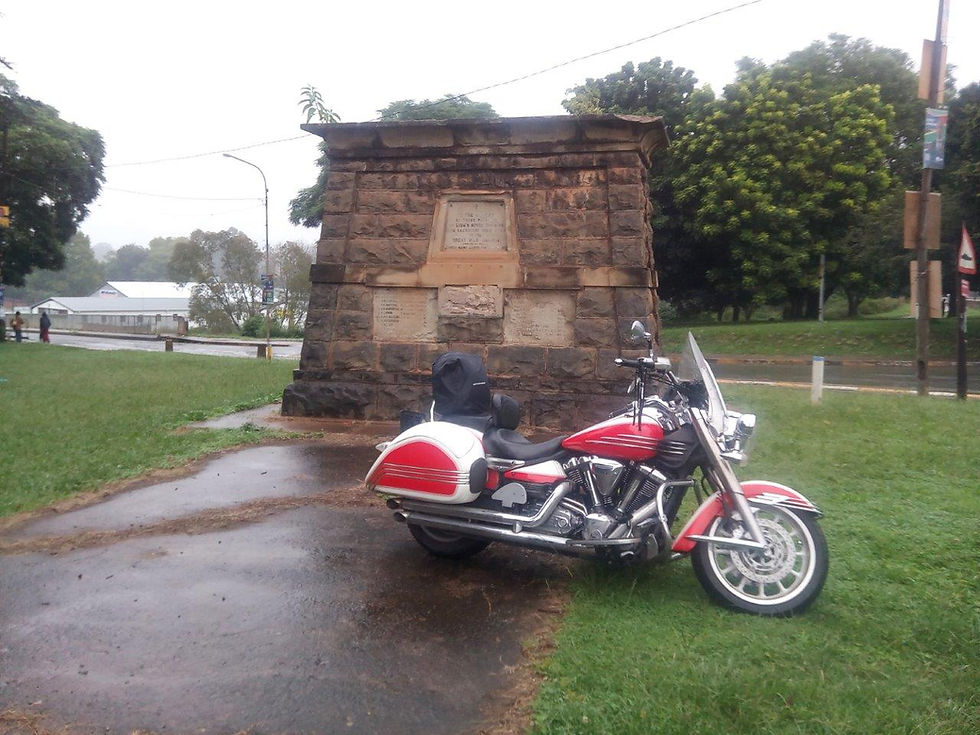
Along the same street leading from Main road Howick up to the spectacular Howick Falls, are the following attractions:
• Old Agricultural Hall • Howick Falls view point
• Howick Falls Hotel
Built in 1872 the Howick Falls Hotel has a very proud history and can count such famous historic icons as Henry Morton Stanley, Mark Twain, Paul Kruger and Cecil John Rhodes amongst its past guests.
It is worth the extra few metres travel down to the Howick Falls viewpoint - just be wary that this has become a traders gathering place and caution must be taken about leaving valuables on your bike.

Other attractions close by to Howick:
Underberg was established in 1917 when the railway from Pietermaritzburg reached the area.
About 2km from Underberg town on the Bulwer side – is a lookout point onto the town and the Umzimkulu River. It features a sandstone sign board and is a safe and convenient place to stop and take photograph no. CP07. Hopefully the main sign board is erected soon - which would make the picture more interesting!

For the slightly more adventurous riders, the following is an amazing visit well worth the small distance travelled from the main road.
• AP07a – the Reichenau Mission

The Reichenau Mission stands on the banks of the Pelola River, exactly 15 kilometres along the R617 from Underberg to the turnoff in the direction of Bulwer. A 2km ride down a dirt road takes you to the bridge, being the Mission entrance.
The mission, founded in 1886, was the first satellite station of the famous Mariannhill Mission near Durban.
Abbot Francis Pfanner, of the New Reformed Cistercian order of monks (commonly known as Trappists), came out to South Africa during the early 1800s. He first established Mariannhill Mission near Pinetown and then the satellite mission at Reichenau.
Self-sufficiency was a fundamental part of the Trappist doctrine. True to this principle, the monks also erected a school, mill, butchery, bakery, forge and store around the church - all constructed of stone. Only a few buildings are still in active use - the church, school and mill.
As for the impressive stone church... with its beautiful murals and richly coloured stained-glass windows, Reichenau was modelled on the Gothic style of its namesake - a Benedictine monastery located on the island of Reichenau on Lake Constance in central Europe.
The church is a must-see if you do visit the Mission proper, but be aware that you will have to pay a R30 per person fee if you take the official tour.
An active community project (and accompanying restoration) is currently being conducted at the Mission by the Reichenau Mill Restoration Project.
On the day of our visit, there had been extensive rain and it was not a good idea to cross the muddy bridge on our bikes. Check out Thom doing the "soft-shoe shuffle"!
CP08: St Patrick’s Catholic Cathedral - Kokstad
Kokstad is named after the Griqua chief Adam Kok III - who settled here in 1863.
Friar John Nicholas Meyer was assigned as the first parish priest in Kokstad in 1884. In September of that year, soldiers of the Cape Mounted Riflemen built a small chapel, which served as the first church. The cornerstone of the current building was laid on 27 February 1924 by Adalbero Fleischer, then Apostolic Vicar of Mariannhill, and construction was completed later that year.
If you are not fortunate enough to find the gates open and can't get close up to the magnificent building - you can still get a great photo from the sidewalk!

CP09: The Royal Hotel - Matatiele
Matatiele is situated in the shadow of the Matatiele Mountain in the former ‘no man’s land’ that during the latter part of the 19th century was the home of horse thieves, gun runners and smugglers - something like an African version of the Wild West.
Dating back to 1919 – the Royal Hotel in Matatiele has changed very little structurally from the early photo below taken in 1920 and how it looks today. It is now known as the Royal Courtyard, featuring new accommodation annexes built onto the original structure.


An alternative structure further down the main road, is:
• AP09a – the Holy Trinity Parish Roman Catholic Church (1952)

CP10: War Memorial - Maclear
The town of Maclear was founded in 1876 as a military camp and developed rapidly, reaching municipal status in 1916. It was named after Sir Thomas Maclear (1794-1879) - a famous astronomer who laid the foundation for a trigonometrical survey of the Cape Colony.
The War Memorial featured below pays tribute to both great wars - 1914-1918 and 1939-1945 – also serving as a tourist information centre.
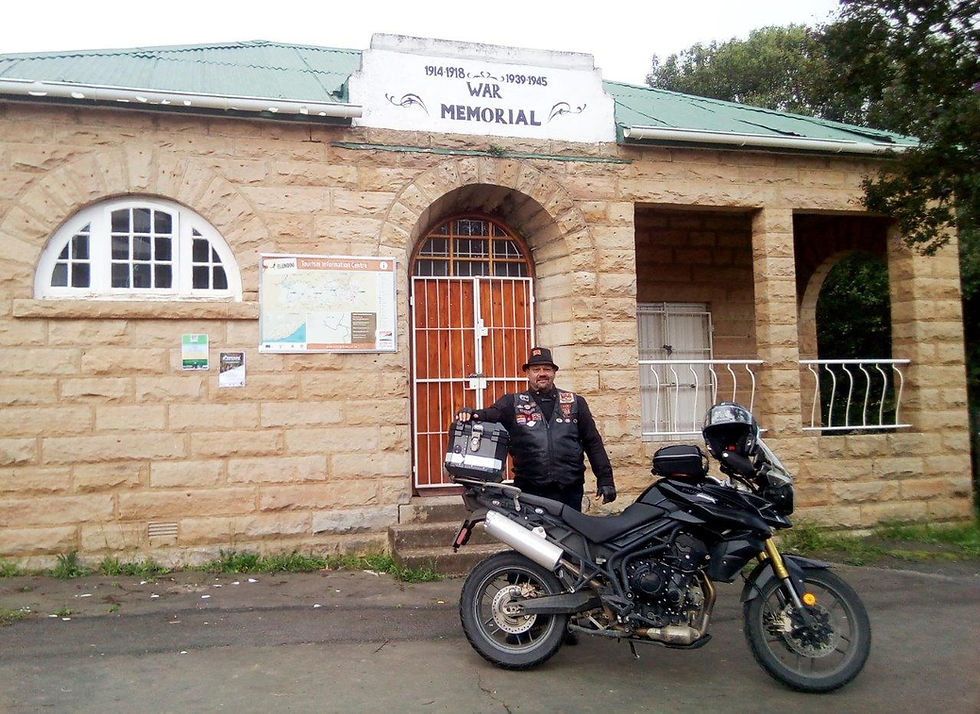
Just across the road, are other magnificent stone buildings – namely:
• AP10a – the Standard Bank • AP10b - The Bean & Bun Coffee Haus
CP11: NG Church - Elliot
Elliot was established in 1885 and first known as Slang River. In April 1894 it received its current name - after Sir Henry George Elliot (1826-1912), who was the Chief Magistrate of the Transkeian territories from 1891 to 1902.
Elliot's NG church building was erected in 1932. A most amazing feature is the “mini-me” wall of remembrance, which the congregation erected in 2008 as a replica of the main church building.
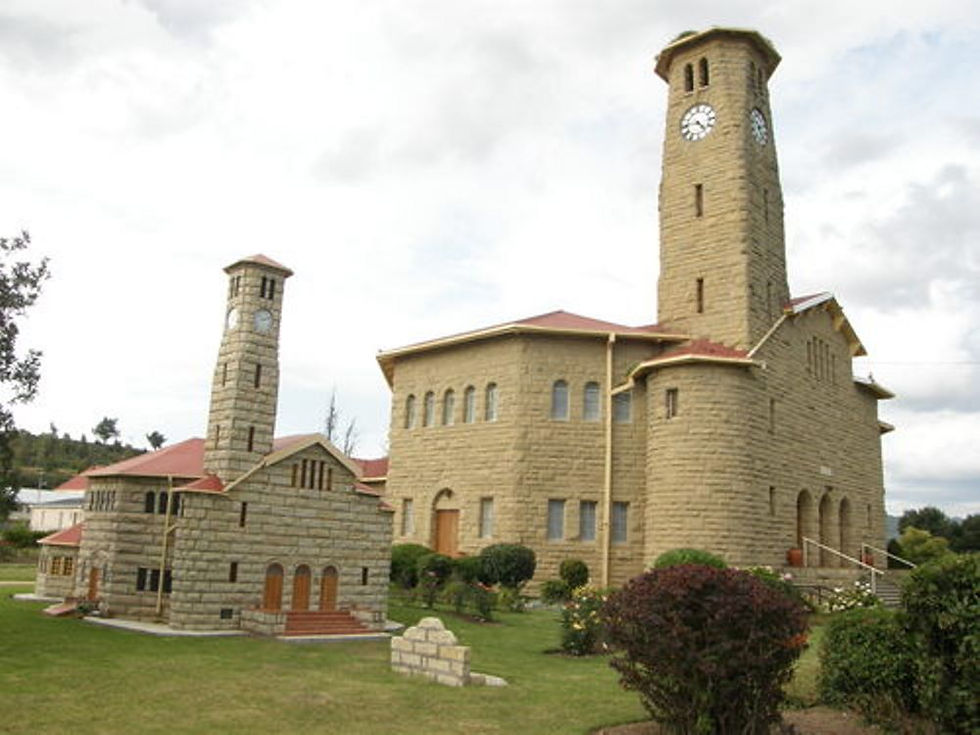
CP12: NG Church – Barkly East
Barkly East is named after Sir Henry Barkly, Governor of the Cape Colony from 1870 to 1877 and is a small village located on the banks of the Cacadu River. The village is one of the highest in South Africa, at 1777m above sea level.
Seen below, the cornerstone of the NG church was laid on December 15, 1906.

CP13: NG Church – Lady Grey
Lady Grey was established on the farm Waaihoek, having been purchased by the Dutch Reformed Church of Aliwal North on 30 April 1857 for the purpose of founding a new congregation. It was named in honour of Eliza Lucy Grey (née Spencer), daughter of Sir Richard Spencer, and wife of Sir George Grey the Cape governor.
The NG Church building was inaugurated on Saturday, July 12, 1913 and seats 800 people.
CP14: Dutch Reformed Church Hall – Zastron
Zastron was laid out in 1876 on Jan Hendrik de Winnaar's farm Verliesfontein and became a municipality in 1881. The town is named after Johanna Sibella Zastron who married J.H. Brand, President of the Orange Free State Republic from 1864 to 1888.
Just around the corner from the highly recommended Nel’s Restaurant in Zastron, is located the Dutch Reformed Church Hall in Reichenberg Street - dating back to 1935. Not quite the steps of parliament, but the portal of this old building made for a great group photo.
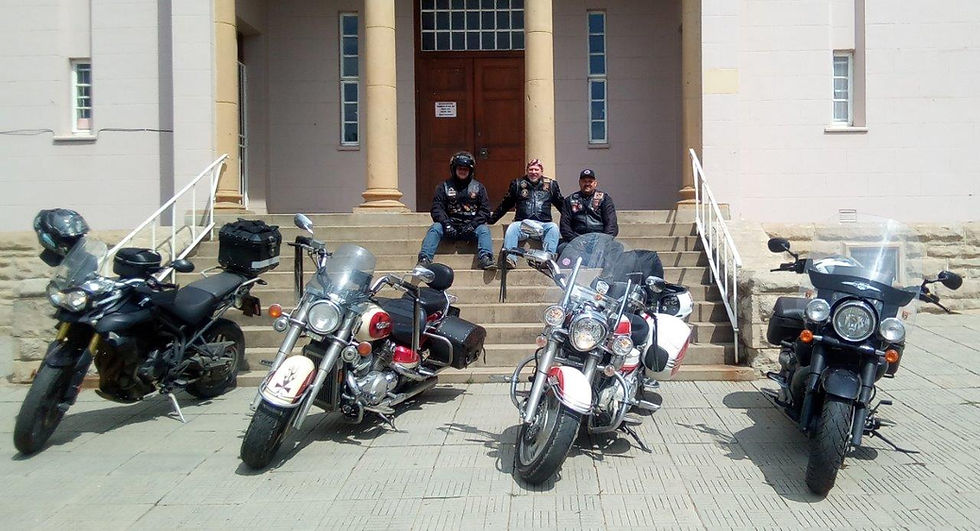

From Zastron, the scenic Maluti Mountains of Lesotho can be seen in the distance, but it’s more likely you’ll be focused on the remarkable rock formation known as the Eye of Zastron, keeping watch over the town.
The “eye” is natural, nine meter diameter hole in a huge freestanding sandstone rock formation on the slopes of the Aasvoëlberg. Myths and legends abound as to what formed the opening - but whatever the theory, the Eye is worth locating.
In October, the town celebrates its famed geological oddity with the "Gatfees" (the hole festival), which includes a half marathon, music concerts and an overdose of friendly Free State hospitality.
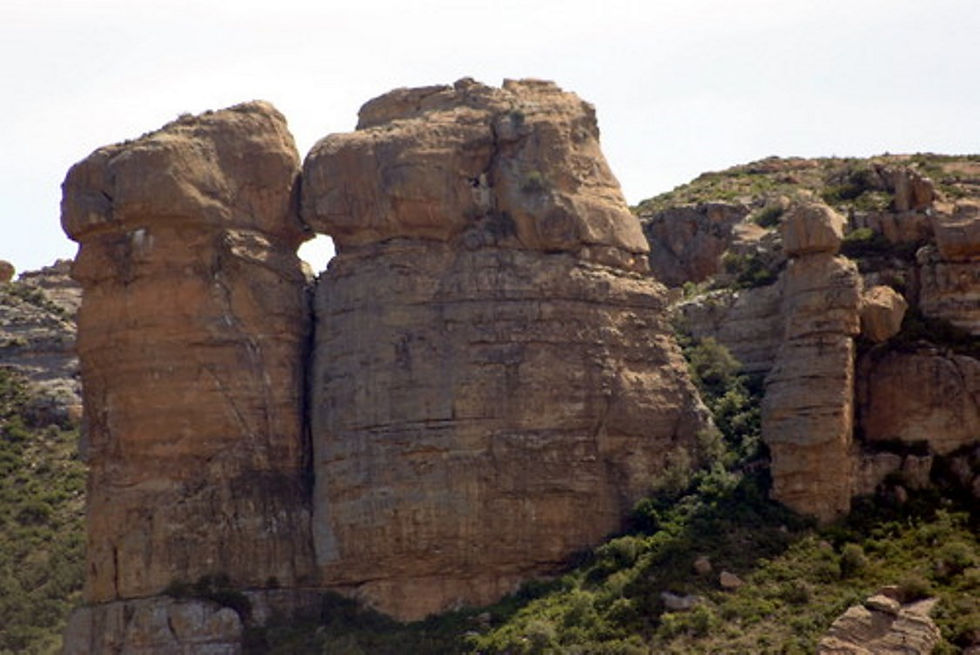
CP15: NG Church - Wepener
The town is named after Louw Wepener - the leader of the Boers in their war with the Basotho chief Moshoeshoe the first - in 1865. It was founded in 1867 on the banks of Jammersbergspruit, a tributary of the Caledon River, with the Jammerberg (Mountain of Sorrow) towering over the village.
All the way down Church Street on the Lesotho end of town, you will encounter the majestic NG church building, where the original cornerstone was laid in 1884. You will see very little change in the appearance of the building between the photo taken in 1917 and 2019 - 102 years later!
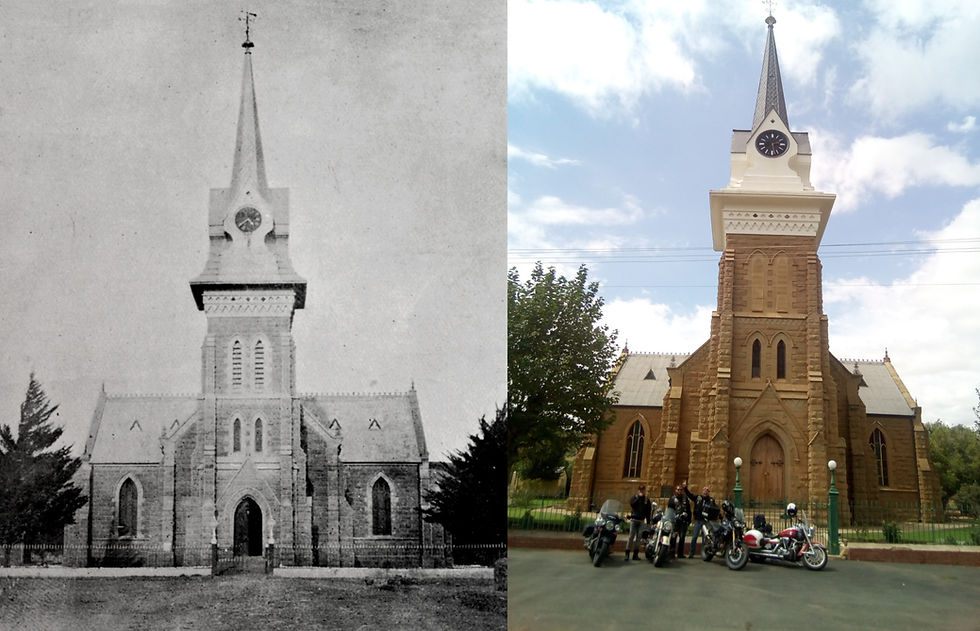

CP16: NG Church - Ladybrand
Founded in 1867 following the Basotho Wars, the town was named after Lady Catharina Brand, the wife of the president of the Orange Free State, Johannes Brand.
On December 20, 1872 , NG Church Ladybrand graduated from the parent congregation in Reddersburg.
Initially, services were held in a smaller church building, which threatened to collapse. The congregation then decided to erect a new church building and for that they received £ 100 from the Free State Council. The total cost of erecting the new church was £ 864.11 and it was commissioned on July 13, 1883.
Like most of the NG churches discovered, the Ladybrand NG congregation's gates were also open - allowing for a grand tour around the building.
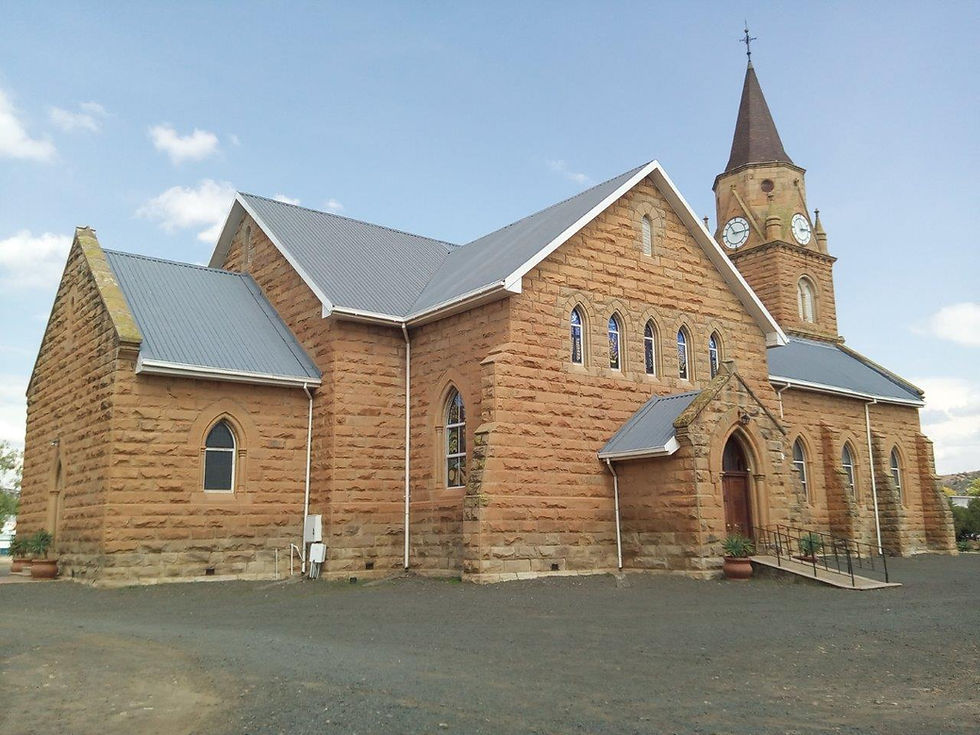
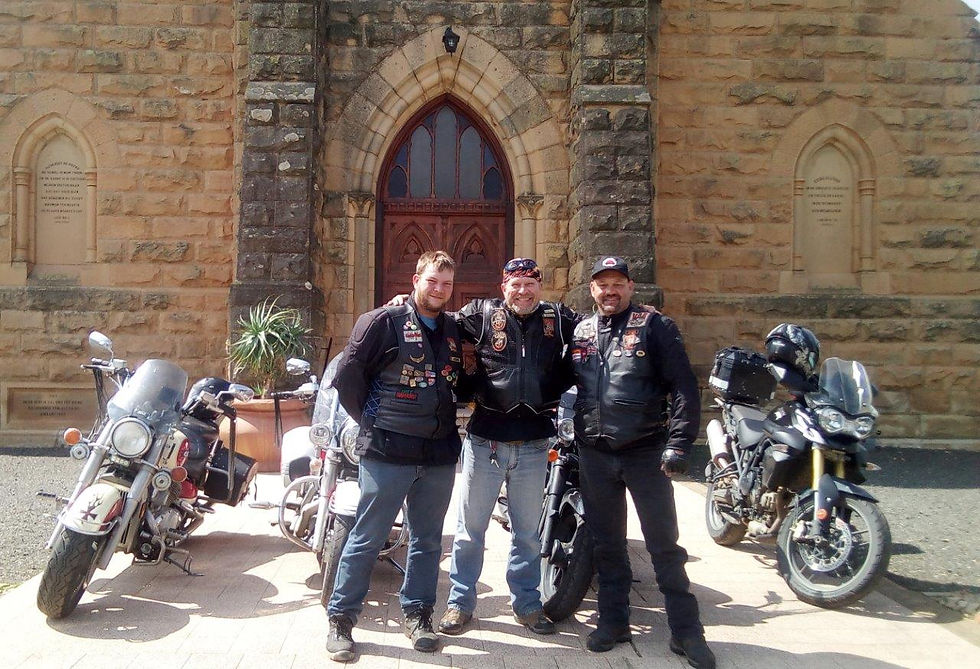
CP17: Town Hall - Ficksburg
Ficksburg was founded in 1883 and named after General Jan Fick, Commander-General of the old Orange Free State Republic. General Fick’s responsibility was to protect the border between the then Basutoland and the Orange Free State. The government encouraged settlers by offering them land, horses, guns and ammunition in return for settling along the boundary of the new territory, to try and discourage the Basotho from crossing the border.
Ficksburg’s claim to fame is the annual Cherry Festival held in November each year – with the cherry crops being harvested from October to December.
The district is renowned for the breathtaking sandstone formations and many of the older buildings in and around the town were built from this material. Interestingly, the Union Buildings in Pretoria are built from sandstone quarried in the surrounding area.
There are numerous magnificent sandstone buildings in Ficksburg, but we have chosen the Town Hall as a fine example of the local architecture. The cornerstone of the building was laid on the 21st July 1897 by Mr M I Fourie, the then chairman of the municipality. It was completed before the outbreak of the Anglo Boer War and is a National and Provincial Heritage Site.
Very close to the Town Hall - one can view the memorial to General Fick a few metres away.


Alternative structures in and about town are:
• AP17a – The Dutch Reformed Church Ficksburg (1869) • AP17b – Gumtree Mill Building - About 20km outside Ficksburg, the old mill building is the tallest sandstone structure in the world - sadly no longer in use.
CP18: Windmill Pub & Grill - Fouriesburg
Fouriesburg was established in 1892 on a farm named Groenfontein and is named after its owner, Christoffel (Rooi Stoffel) Fourie. This area served as a temporary seat of the Free State government during the Anglo-Boer War.
One of many amazing sandstone buildings in Fouriesburg – the Windmill Pub & Grill is a great “kuier–plek” and worthy of a stop-over.

• AP18a - Fouriesburg Country Inn (1892) • AP18b - Fouriesburg Dutch Reformed Church • AP18c - Fouriesburg town hall • AP18d – Fouriesburg Post Office
We spent our last night in Clarens and could easily raise our glasses to toast the weekend's ride. Really looking forward to completing the Lesotho Sandstone Challenge for real!







































































